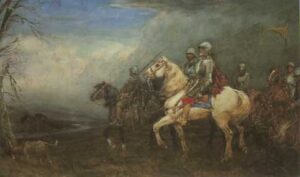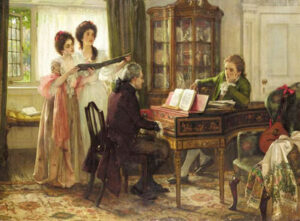This is where I live, and this is one of my favourite mornings.
Author Archives: eotaur
Audiobooks

I love listening to audiobooks. Now you can listen to The Ill-Made Mute as an audiobook, and hear the pronunciation of all those outlandish words and names you wondered about.
The Lady of the Sorrows audiobook is now available on Kobo and will soon be everywhere else.
The hands that wrote the Bitterbynde Trilogy
Cecilia writes in a notebook.
The voice of CDT
Cecilia reads a poem from ‘The Ill-Made Mute’.
The first page of The Ill-Made Mute
Here’s another short video . . . .
Quote . . . Unquote

Is it just me, or is anyone else mystified by the fact that so many people say, “Quote, unquote” before they utter a quotation? I admit that I’m a grammar and punctuation nerd, but it seems to me that logically, it makes more sense to just say “quote” before uttering the relevant phrase, and then “unquote” afterwards – as you would if you were writing it down. Or if you’re really pushed for time, you could just say “quote”.
If you immediately say “unquote” after “quote”, your verbal quotation marks contain nothing. You end up with a quotation that consists of zilch, followed by a statement that may or may not be a quotation.
Maybe people do this because they’re worried about forgetting to close the quotation marks at the end of the quotation, so they think they might as well close them straight away, before they even begin the quotation, and get it over with. . . ?
What do you think?
Of course you could always do squiggly, rabbit ear “air quotes” with your fingers to indicate quotes. The advantages of this being that you can communicate with deaf people, while simultaneously looking hilariously sarcastic. 🙂
The mysterious world of Aia
Here’s a short video that perhaps captures the mystery of the world of Aia, which is the setting for the Bitterbynde Trilogy. It was originally made as a trailer for the audiobook of The Ill-Made Mute. I hope you enjoy it.
The Northern Threat
Border reivers.

I was rereading one of my own books the other day, (because it’s being made into an audio-book – hurrah!), and I was reminded of the concept of “dangerous northern dwellers, who are always threatening to surge down south and cause mayhem”.
I started writing THE ILL-MADE MUTE twelve years before it was published, because it took me four years to write each book of the BITTERBYNDE trilogy. In other words, I started around the year 1988. By that stage of my life, the concept of perilous northern raiders was ingrained into my psyche. Which is how they got written into the book.
This is because I was raised on a diet of books that included a great deal of British history, such as the wonderful books of Rosemary Sutcliff and Andre Norton. And throughout British history runs a theme of Dark Forces in the North, threatening the more civilised forces in the south.
Even Mrs Gaskell’s classic NORTH AND SOUTH hints at this. In it, Northerners are typically “hard”, and live in a hellish landscape, while Southerners are soft and live amongst gardens. When I started writing my trilogy it seemed natural to me to invent a world in which trouble was brewing at the northern end. The idea of a wall between north and south also seemed somehow natural, and rather exciting. I’m guessing that’s due to the ghost of Hadrian’s Wall haunting my mind, when I was a child.
Throughout much of British history, there have been border reivers. They were raiders and outlaws along the Anglo-Scottish border from the 13th to the 16th century, who took advantage of a fraught and explosive border region over those centuries. Their feats have blended into folklore. “There were reiver families and clans on both sides of the border – the English reivers would raid into Scotland and vice versa.” [Wikipedia]
Probably, many of the books I read as a child were written by southerners who might have had a biased impression of the northerners, which is why I ended up with that impression.
Incongruously, my reading left Young Me with the impression that “north is cold”. “Cold north wind” is a phrase that sounds right to my ears, despite the fact that where I live, the north wind in summer comes roaring with the breath of a furnace.
Combined with the Christmas cards of my childhood, that depicted snow and robins, this made for mentally living in two worlds simultaneously. Which is, surprisingly, a boon for a writer.
The Power of Three

The concept of the “power of three” has been present in various cultures and disciplines throughout history.
It refers to the idea that things that come in threes are inherently more satisfying, memorable, and effective than other numbers.
It has religious or cultural significance in many societies. “Threeness” is a recurring theme that people use to enhance communication and impact.
“Three” in literature
In literature, the power of three is often used in storytelling to create a satisfying narrative. For example, the three little pigs, the three musketeers, and the three witches in Shakespeare’s Macbeth are all examples of the power of three in action. This principle applies to other media as well, such as film, music, and even stand-up comedy, where comedians often use a three-part structure to create a punchline.
“Three” in marketing
In marketing, the power of three is used to create memorable and effective advertising campaigns. Advertisers often use three-word slogans, such as Nike’s “Just Do It”, to create a simple and catchy message that is easy to remember. Additionally, product packages are often sold in threes, such as shampoo bottles or snack packs, to create a sense of completeness and to encourage consumers to purchase more.
“Three” in religion
In religion, the power of three is often used to represent a divine unity or trinity. In Hinduism, for example, there are three major gods: Brahma, Vishnu, and Shiva. This concept of the power of three in religion can also be seen in other spiritual and mystical practices, such as Wicca and Druidry.
Amazing “three”
You can read more about the number 3 here.
By using the power of three with its associated symbolism, writers can create messages that are more satisfying, memorable, and effective. (How many fantasy trilogies do you know of?) 🙂
Inspirations for “The Churchyard Yarrow” & “Madigan’s Leap”

The inspiration for writing Madigan’s Leap in the first place was British and Irish folk music. I have always loved the lyrics and melodies of folk songs, and grew up listening to the music of, amongst others, Steeleye Span and Fairport Convention. The fascinating—and to me, unusual—lyrics of many of these songs taught me much about history.
In particular I found the horrific stories of press gangs in the 18th and early 19th century quite compelling. I felt driven to write a story about this onerous practice and the effect it must have had on young men, and indeed on entire families in that time and place.
Thus, thanks to music, I found myself writing about the last decade of the 19th century and the first few years of the 19th—in other words, the Regency era and the Napoleonic era.
Wikipedia says “The Regency era of British history is commonly applied to the years between c. 1795 and 1837, although the official regency for which it is named only spanned the years 1811 to 1820.”
“Madigan’s Leap” is set in an alternative version of Ireland during this era. It incorporates many aspects of the social, political and geographical elements of Ireland at that time, but I am a fantasy writer, after all, so this is a fantasy tale, and it bends many of the facts to suit the story.
I did my best, nonetheless, to clothe the characters in some of the (hopefully) historically accurate and exquisite costumes of that time. Most people agree, it was a time of exceptionally stylish attire for the military and for the wealthy. Isn’t that one of the many reasons we all love the novels of Jane Austen? 🙂 It is also said that “The uniforms of the Napoleonic Wars were some of the most elaborate and dashing in military history.”

